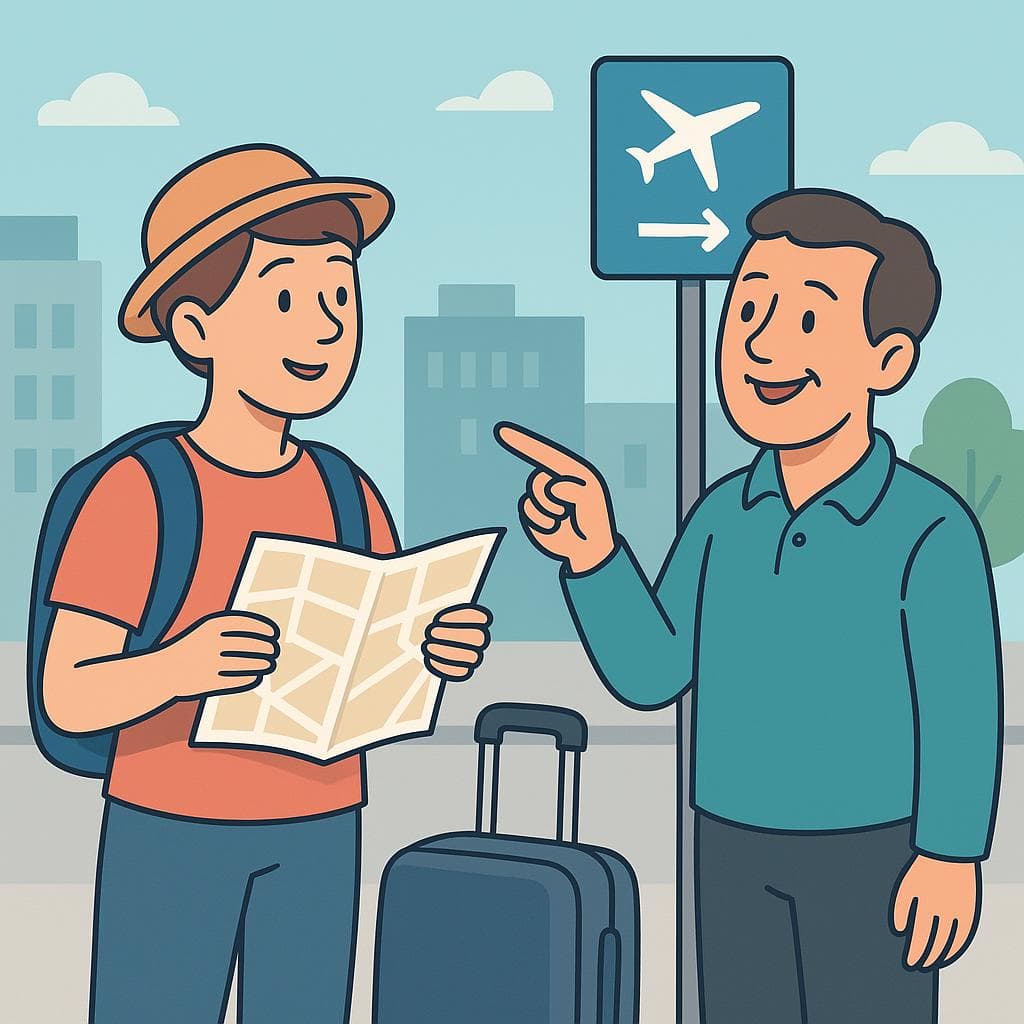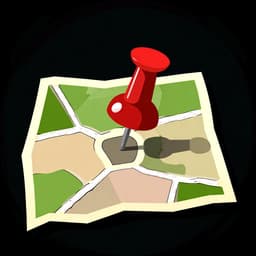Where is the airport?
in Spanish¿Dónde está el aeropuerto?
/DOHN-deh ehs-TAH el ah-eh-roh-PWER-toh/
This is the most direct, common, and universally understood way to ask for the airport's location. It's suitable for any situation, from asking a stranger on the street to speaking with hotel staff.

Knowing this simple question is your key to navigating any new city in the Spanish-speaking world.
💬Other Ways to Say It
Disculpe, ¿dónde está el aeropuerto?
/dees-KOOL-peh, DOHN-deh ehs-TAH el ah-eh-roh-PWER-toh/
This is the polite version of the main phrase, adding 'Excuse me' at the beginning. 'Disculpe' is used to get someone's attention respectfully, especially an older person or someone in a position of authority.
Perdón, ¿dónde está el aeropuerto?
/pehr-DOHN, DOHN-deh ehs-TAH el ah-eh-roh-PWER-toh/
Similar to 'Disculpe', 'Perdón' means 'Pardon me' or 'Excuse me'. It's slightly less formal than 'Disculpe' but is still very polite and appropriate for getting someone's attention.
¿Dónde queda el aeropuerto?
/DOHN-deh KEH-dah el ah-eh-roh-PWER-toh/
In many parts of Latin America, using the verb 'quedar' is just as common, if not more common, than 'estar' to ask where something is located. It means the exact same thing.
¿Cómo llego al aeropuerto?
/KOH-moh YEH-goh ahl ah-eh-roh-PWER-toh/
This phrase means 'How do I get to the airport?'. It's a great alternative because you're not just asking for the location, but specifically for directions on how to get there.
¿Me podría decir dónde está el aeropuerto, por favor?
/meh poh-DREE-ah deh-SEER DOHN-deh ehs-TAH el ah-eh-roh-PWER-toh, por fah-VOR/
This is a very polite and slightly more complex way to ask: 'Could you tell me where the airport is, please?'. It's formal and shows a high level of respect.
¿Para ir al aeropuerto?
/PAH-rah eer ahl ah-eh-roh-PWER-toh/
This is a shortened, more conversational way of asking, literally 'To go to the airport?'. It's an incomplete sentence, but it's understood as a request for directions.
🔑Key Words
Key Words to learn:
📊Quick Comparison
Here’s a quick comparison of the most common ways to ask for the airport, so you can pick the best one for your situation.
| Phrase | Formality | Best For | Avoid When |
|---|---|---|---|
| ¿Dónde está el aeropuerto? | Neutral | A direct, universal question for almost any context. | It's never wrong, but adding 'Disculpe' is better for approaching strangers. |
| ¿Dónde queda el aeropuerto? | Neutral | Sounding natural and local in most of Latin America. | In Spain, where 'está' is much more common for location. |
| ¿Cómo llego al aeropuerto? | Neutral | Asking for transportation advice or step-by-step directions. | You just want to know the general location on a map. |
| ¿Me podría decir dónde está...? | Formal | Being extra polite, especially with officials or older people. | A quick, casual interaction where it might sound overly formal. |
📈Difficulty Level
The phrase itself is easy, but 'aeropuerto' (ah-eh-roh-PWER-toh) can be a mouthful for beginners due to the number of vowel sounds.
It's a very simple structure. The key is remembering to use 'está' for location, which is a fundamental rule for beginners.
The main nuance is the importance of politeness. Using 'Perdón' or 'Disculpe' is a simple cultural key that makes a big difference.
Key Challenges:
- Pronouncing 'aeropuerto' clearly
- Remembering to use 'está' instead of 'es' for location
💡Examples in Action
Disculpe, señor, ¿dónde está el aeropuerto internacional?
Excuse me, sir, where is the international airport?
Hola, necesito un taxi. ¿Sabe cómo llego al aeropuerto desde aquí?
Hi, I need a taxi. Do you know how I get to the airport from here?
En este mapa no lo veo. ¿Me podría indicar dónde queda el aeropuerto?
I don't see it on this map. Could you show me where the airport is located?
El autobús número 5 va para el aeropuerto, ¿verdad?
Bus number 5 goes to the airport, right?
🌍Cultural Context
Politeness First
In Spanish-speaking cultures, it's considered polite to start any question to a stranger with a greeting or a polite opener. Simply walking up and asking '¿Dónde está el aeropuerto?' can feel a bit abrupt. Using 'Hola,' 'Buenos días,' 'Perdón,' or 'Disculpe' first will get you a much warmer response.
International vs. Domestic
Many large cities have multiple airports or terminals. If you know you need the international one, it's helpful to specify 'el aeropuerto internacional'. If you're taking a local flight, you might ask for 'el aeropuerto nacional' or 'el de vuelos domésticos'.
Hand Gestures are Part of the Answer
Don't be surprised if the answer to your question involves a lot of hand gestures, pointing, and maybe even a 'pursed lips' gesture to indicate a direction. Pay attention to body language as it's often just as important as the words spoken.
❌ Common Pitfalls
Using 'es' instead of 'está'
Mistake: "¿Dónde es el aeropuerto?"
Correction: ¿Dónde está el aeropuerto?
Mispronouncing 'Aeropuerto'
Mistake: "Saying 'air-o-porto' or 'a-rio-puerto'."
Correction: ah-eh-roh-PWER-toh
Forgetting the 'al'
Mistake: "¿Cómo llego el aeropuerto?"
Correction: ¿Cómo llego al aeropuerto?
💡Pro Tips
Have the Airport Name Ready
If you know the name of the airport (e.g., 'Barajas' in Madrid, 'El Dorado' in Bogotá), use it! Asking '¿Dónde está el aeropuerto de Barajas?' is more specific and can prevent confusion if a city has more than one airport.
Learn Basic Direction Words
After you ask your question, you'll need to understand the answer. Learn key words like 'derecha' (right), 'izquierda' (left), 'todo recto' (straight ahead), and 'lejos' (far) to make sense of the directions you receive.
Combine with 'Por Favor'
Adding 'por favor' (please) to the end of your question is always a good idea. For example, '¿Dónde está el aeropuerto, por favor?' is a simple, polite, and effective phrase.
🗺️Regional Variations
Spain
Usage of 'está' is almost universal for location; 'queda' is rarely used in this context. The vosotros form might be used when receiving directions from a group ('seguid todo recto').
Mexico
Both 'está' and 'queda' are extremely common and interchangeable. Mexicans are generally very polite and will appreciate a 'Disculpe' or 'Buenos días' before the question.
Argentina
'Queda' is more common than 'está'. The use of 'vos' instead of 'tú' is standard, so you might hear responses like 'vos tenés que...' (you have to...). 'Che' is a very common, informal way to get someone's attention.
Caribbean (e.g., Cuba, Puerto Rico, Dominican Republic)
The language is very direct and informal. 'Coger' (to take/grab) is commonly used for directions, as in 'coge la primera a la derecha' (take the first right). Note: 'coger' has a vulgar meaning in some other countries like Argentina and Mexico, but it's perfectly normal here.
💬What Comes Next?
After you ask where the airport is.
Está a unos 20 minutos en taxi.
It's about 20 minutes away by taxi.
Perfecto, muchas gracias.
Perfect, thank you very much.
They give you directions.
Siga todo recto por esta calle y lo verá a la izquierda.
Go straight on this street and you'll see it on the left.
Entendido, gracias por su ayuda.
Understood, thanks for your help.
They ask for clarification.
¿A qué terminal va?
Which terminal are you going to?
Voy a la terminal de vuelos internacionales.
I'm going to the international flights terminal.
🧠Memory Tricks
This breaks down the long word into two memorable parts, one of which is very similar to its English equivalent.
This silly sentence connects the sound of the Spanish words to an English question about location, helping you remember the phrase's purpose.
🔄How It Differs from English
The biggest difference is the Spanish use of two verbs for 'to be': 'ser' and 'estar'. English uses 'is' for everything, but in Spanish, location *always* requires 'estar'. Asking '¿Dónde es el aeropuerto?' is grammatically incorrect because the airport's location is a state, not an inherent characteristic. This is a fundamental concept in Spanish that English speakers must master.
🎯Your Learning Path
➡️ Learn Next:
How to ask for the train station
You can swap 'aeropuerto' for any other location, like 'la estación de tren'.
How to ask how far something is
A natural follow-up question is '¿Está lejos?' (Is it far?).
How do I get to...?
This broadens your ability to ask for directions to any place, not just the airport.
How to say thank you
After someone helps you, you'll always need to know how to thank them.
Understanding basic directions
Learning words like 'right', 'left', and 'straight' is essential to understand the answer to your question.
✏️Test Your Knowledge
💡 Quick Quiz: Where is the airport?
Question 1 of 3
You've just arrived in Bogotá, Colombia, and need to find the airport. What is the most natural, local-sounding way to ask a stranger?
Frequently Asked Questions
What's the real difference between '¿Dónde está?' and '¿Dónde queda?'
Functionally, they mean the exact same thing: 'Where is it located?'. The difference is purely regional. '¿Dónde está?' is understood everywhere, but is the preferred phrase in Spain. '¿Dónde queda?' is very common throughout Latin America and using it there can make you sound more like a local.
Is it rude to just ask '¿Dónde está el aeropuerto?' without saying hello first?
It can be seen as a bit abrupt or blunt, especially to an older person. It's always better to start with a simple 'Hola' (Hello), 'Perdón' (Pardon me), or 'Disculpe' (Excuse me). This little bit of politeness goes a long way in Spanish-speaking cultures.
How can I practice pronouncing 'aeropuerto' correctly?
Break it into syllables and say it slowly: ah - eh - roh - PWER - toh. Notice how every vowel sound is pronounced clearly. The stress is on the 'PWER' syllable. Try saying it five times in a row, getting a little faster each time.
What if I don't understand the directions they give me?
Don't worry, this is very common! You can say 'Más despacio, por favor' (Slower, please) or 'No entiendo' (I don't understand). It's also helpful to have a map app open on your phone; you can say '¿Me puede mostrar en el mapa?' (Can you show me on the map?).
Should I use 'Disculpe' or 'Perdón'?
They are very similar and often interchangeable. A good rule of thumb is to use 'Disculpe' to get someone's attention before you ask a question, and 'Perdón' if you accidentally bump into them. However, using 'Perdón' to start a question is also perfectly fine and very common.
📚Continue Learning Spanish Phrases
Explore More Phrases in These Categories
Find similar phrases to expand your Spanish vocabulary:
Want to Learn More Spanish Phrases?
Browse our complete collection of Spanish phrases organized by situation, from basic greetings to advanced conversations. Perfect for travelers, students, and anyone learning Spanish.
View All Spanish Phrases →





